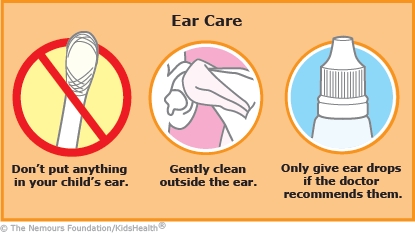Otorrhea (ote-uh-REE-uh) is when fluid drains from the ear. It can happen because of an infection, a hole in the eardrum, something being stuck in the ear canal, or a buildup of earwax. When the cause is treated, it usually gets better with regular ear care.



Your child:

Does otorrhea cause any other symptoms? Otorrhea can cause vertigo (a spinning feeling), ear discomfort or itching, ringing in the ear, or hearing loss. When the otorrhea stops, these other problems usually go away too.
What if a child with ear tubes has otorrhea? Ear tubes are tiny tubes placed in the eardrum to prevent ear infections. But sometimes an infection can happen. This leads to thick drainage that comes through the tubes and into the ear canal. Health care providers prescribe antibiotic drops or antibiotics to be taken by mouth to treat the infection.
Is a hole in the eardrum (a perforation) from an infection serious? Although a hole in the eardrum sounds like it would be serious, it's usually not. Typically, the eardrum heals very quickly. Most kids have no problems after the eardrum heals.